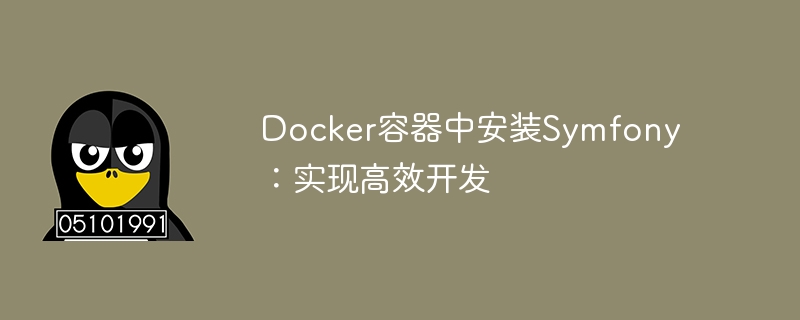

Installing Symfony in Docker containers: achieving efficient development
Introduction:
Symfony is an open source web application framework written in PHP that provides a set of Efficient tools and components to simplify the web application development process. Using Symfony can reduce development time and improve code maintainability and scalability. Using Docker containers to install Symfony can further improve development efficiency and reduce the complexity of environment configuration. This article will introduce in detail how to install Symfony in a Docker container and give specific code examples.
1. Understanding Docker containers
Docker is an open source containerization platform that can package applications and their dependencies in a lightweight, portable container. Using Docker can provide a consistent operating environment so that applications can run stably in different environments. By using container technology, we can easily package Symfony and all dependencies together and deploy and test them in different development environments.
2. Install Docker
First, we need to install Docker. Docker provides official installation packages and supports multiple operating systems, including Windows, Mac and Linux. Choose the installation package suitable for your operating system and install it according to the official documentation.
3. Create the Symfony project
After installing Docker, we can start creating the Symfony project. Open a terminal and execute the following command to create a Symfony project:
$ docker run --rm -v $(pwd):/app composer create-project symfony/skeleton my_project
The above command will create a Symfony project named my_project in the current directory.
4. Create Docker images and containers
Next, we need to create a Docker image and package the Symfony project in it. Create a file named Dockerfile in the root directory of the Symfony project with the following content:
FROM php:7.4-cli
RUN apt-get update && apt-get install -y
libicu-dev
libzip-dev
zip
RUN docker-php-ext-configure intl &&
docker-php-ext-install intl
RUN docker-php-ext-install zip
COPY . /var/www/html/
WORKDIR /var/www/html
CMD ["php", "-S", "0.0.0.0:8000", "-t", "public"]The above Dockerfile uses the official PHP 7.4 image as the base image, and installs some extensions and dependencies required by Symfony item.
Next, we need to use the Docker command to build the image:
$ docker build -t symfony-app .
With the above command, we create a Docker image named symfony-app.
Next, we can use the following command to start a Docker container and map the container to the local port 8000:
$ docker run -p 8000:8000 -v $(pwd):/var/www/html symfony-app
With the above command, the Symfony application will be in Docker Run in the container and provide services to the outside world through the local port 8000.
5. Test the Symfony application
Open the browser and visit http://localhost:8000. If you can see the Symfony welcome page, it means that the Symfony application has been successfully run in the Docker container.
6. Summary
Through the use of Docker containers, we can easily install and deploy Symfony applications, improve development efficiency, and reduce the complexity of environment configuration. In this article, we detail how to install Symfony in a Docker container and give specific code examples. I hope this article can help developers who are new to Symfony and Docker get started quickly. Happy coding everyone!
The above is the detailed content of Installing Symfony in Docker containers: achieving efficient development. For more information, please follow other related articles on the PHP Chinese website!




